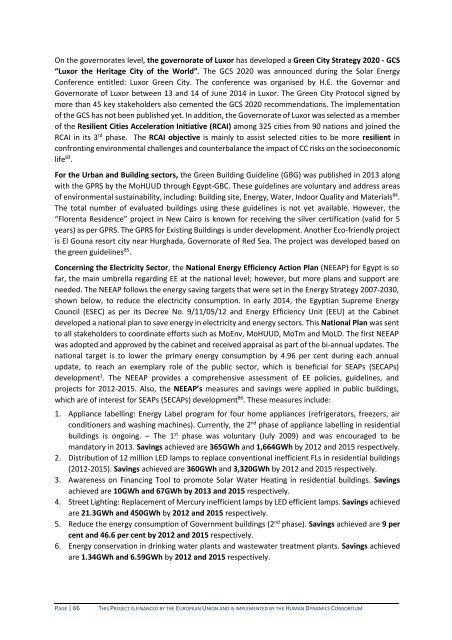180917_CES-MED_National_Report_Egypt_FINAL2rev
You also want an ePaper? Increase the reach of your titles
YUMPU automatically turns print PDFs into web optimized ePapers that Google loves.
On the governorates level, the governorate of Luxor has developed a Green City Strategy 2020 - GCS<br />
“Luxor the Heritage City of the World”. The GCS 2020 was announced during the Solar Energy<br />
Conference entitled: Luxor Green City. The conference was organised by H.E. the Governor and<br />
Governorate of Luxor between 13 and 14 of June 2014 in Luxor. The Green City Protocol signed by<br />
more than 45 key stakeholders also cemented the GCS 2020 recommendations. The implementation<br />
of the GCS has not been published yet. In addition, the Governorate of Luxor was selected as a member<br />
of the Resilient Cities Acceleration Initiative (RCAI) among 325 cities from 90 nations and joined the<br />
RCAI in its 3 rd phase. The RCAI objective is mainly to assist selected cities to be more resilient in<br />
confronting environmental challenges and counterbalance the impact of CC risks on the socioeconomic<br />
life 83 .<br />
For the Urban and Building sectors, the Green Building Guideline (GBG) was published in 2013 along<br />
with the GPRS by the MoHUUD through <strong>Egypt</strong>-GBC. These guidelines are voluntary and address areas<br />
of environmental sustainability, including: Building site, Energy, Water, Indoor Quality and Materials 84 .<br />
The total number of evaluated buildings using these guidelines is not yet available. However, the<br />
“Florenta Residence” project in New Cairo is known for receiving the silver certification (valid for 5<br />
years) as per GPRS. The GPRS for Existing Buildings is under development. Another Eco-friendly project<br />
is El Gouna resort city near Hurghada, Governorate of Red Sea. The project was developed based on<br />
the green guidelines 85 .<br />
Concerning the Electricity Sector, the <strong>National</strong> Energy Efficiency Action Plan (NEEAP) for <strong>Egypt</strong> is so<br />
far, the main umbrella regarding EE at the national level; however, but more plans and support are<br />
needed. The NEEAP follows the energy saving targets that were set in the Energy Strategy 2007‐2030,<br />
shown below, to reduce the electricity consumption. In early 2014, the <strong>Egypt</strong>ian Supreme Energy<br />
Council (ESEC) as per its Decree No. 9/11/05/12 and Energy Efficiency Unit (EEU) at the Cabinet<br />
developed a national plan to save energy in electricity and energy sectors. This <strong>National</strong> Plan was sent<br />
to all stakeholders to coordinate efforts such as MoEnv, MoHUUD, MoTm and MoLD. The first NEEAP<br />
was adopted and approved by the cabinet and received appraisal as part of the bi‐annual updates. The<br />
national target is to lower the primary energy consumption by 4.96 per cent during each annual<br />
update, to reach an exemplary role of the public sector, which is beneficial for SEAPs (SECAPs)<br />
development 1 . The NEEAP provides a comprehensive assessment of EE policies, guidelines, and<br />
projects for 2012‐2015. Also, the NEEAP’s measures and savings were applied in public buildings,<br />
which are of interest for SEAPs (SECAPs) development 86 . These measures include:<br />
1. Appliance labelling: Energy Label program for four home appliances (refrigerators, freezers, air<br />
conditioners and washing machines). Currently, the 2 nd phase of appliance labelling in residential<br />
buildings is ongoing. – The 1 st phase was voluntary (July 2009) and was encouraged to be<br />
mandatory in 2013. Savings achieved are 365GWh and 1,664GWh by 2012 and 2015 respectively.<br />
2. Distribution of 12 million LED lamps to replace conventional inefficient FLs in residential buildings<br />
(2012‐2015). Savings achieved are 360GWh and 3,320GWh by 2012 and 2015 respectively.<br />
3. Awareness on Financing Tool to promote Solar Water Heating in residential buildings. Savings<br />
achieved are 10GWh and 67GWh by 2013 and 2015 respectively.<br />
4. Street Lighting: Replacement of Mercury inefficient lamps by LED efficient lamps. Savings achieved<br />
are 21.3GWh and 450GWh by 2012 and 2015 respectively.<br />
5. Reduce the energy consumption of Government buildings (2 nd phase). Savings achieved are 9 per<br />
cent and 46.6 per cent by 2012 and 2015 respectively.<br />
6. Energy conservation in drinking water plants and wastewater treatment plants. Savings achieved<br />
are 1.34GWh and 6.59GWh by 2012 and 2015 respectively.<br />
PAGE | 66<br />
THIS PROJECT IS FINANCED BY THE EUROPEAN UNION AND IS IMPLEMENTED BY THE HUMAN DYNAMICS CONSORTIUM

















